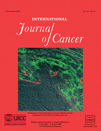Expression profiling reveals genes associated with transendothelial migration of tumor cells: A functional role for αvβ3 integrin
Abstract
Transendothelial migration is a key step in the extravasation of tumor cells during metastasis formation. Here, we have classified 45 human tumor cell lines derived from various tissues according to their capacity for transendothelial migration in vitro. We could distinguish cell lines showing strong transmigration (TEM+ cell lines) from others that did not transmigrate (TEM− cell lines). By DNA microarray analysis we could cluster TEM+ and TEM− cell lines according to their gene expression pattern and identify genes differentially expressed between the 2 groups. Among these we found the integrin β3 subunit to be highly expressed in TEM+ cell lines as compared to TEM− cell lines. Cell surface localization of αvβ3 integrin receptors was exclusively found in TEM+ cell lines. Transendothelial migration of TEM+ cells but not their adhesion to the endothelial cells, or invasion into collagen gels could be blocked with an antibody against αvβ3 integrin and by RNAi mediated knock-down of the integrin β3 subunit. These data establishes αvβ3 integrin as one key component of the transendothelial migration process of tumor cells, and as a potential target for anti-metastatic therapy. Our gene expression analysis of a defined collection of tumor cell lines can be used as a starting point to identify further genes functionally involved in transendothelial migration. © 2007 Wiley-Liss, Inc.




